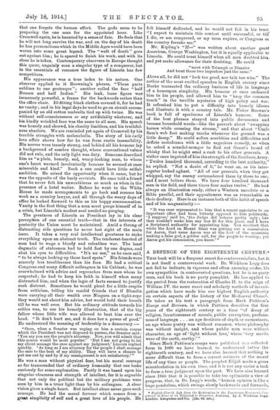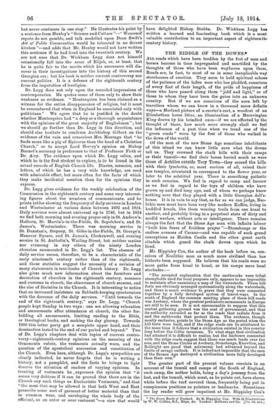A DEFENCE OF THE EIGHTEENTH CENTURY:*
Tuts book will be a frequent resort for controversialists, but it is not itself a controversial work. Dr. Wickham Legg does not fail to indicate, in vigorous and often amusing asides, his own sympathies in controverted questions, but be is no party man, and his book is no party pamphlet. He has applied to the period from the restoration of Charles II. to the reign of William IV. the same exact and scholarly methods of investi- gation which have made him our highest English authority on certain aspects of the history of the Mediaeval Church. He takes as his text a paragraph from Mark Pattison's Essays and Reviews, in which Pattison describes the first years of the eighteenth century as a time "of decay of religion, licentiousness of morals, public corruption, profane- ness of language . . . an age destitute of depth or earnestness, an age whose poetry was without romance, whose philosophy was without insight, and whose public men were without character, an age of light without love,' whose ' very merits were of the earth, earthy.'" Since Mark Pattison's essays were published in a collected form in 1860 we have learned to understand better the eighteenth century, and we have also learned that nothing is more difficult than to form a correct estimate of the moral life of any time or people. The prophet Elijah made a gross miscalculation in his own time, and it is not any easier a task to form a true judgment upon the past. We have also learned since 1860 that it is possible to take too optimistic a view of progress, that, in Dr. Legg's words, "human opinion is like a huge pendulum, which swings slowly backwards and forwards, • English Church Life from the Restoration to the Traclarian Movement, Con- sidered in Some of its Neglected or Forgotten Features. By J. Wickham Legg. London: Longmans and Co. [122. ed. net.] but never continues in one stay." He illustrates his point by a sentence from Huxley's " Science and Culture "—" Womenof repute do not gamble, and talk modelled upon Dean Swift's Art of Pulite Conversation would be tolerated in no decent kitchen "—and adds that Mr. Huxley would not have written this sentence if he had lived into the twentieth century. We are not sure that Dr. Wickham Legg does not himself occasionally fall into the error of Elijah, or, at least, that he is quite fair to the merits which his successors will dia. corer in their investigations into the history of this second Georgian era ; but his book is neither current controversy nor current politics. It is a defence of the eighteenth century from the imputation of irreligion.
Dr. Legg does not rely upon the recorded impressions of contemporaries. He quotes some of them only to show their weakness as evidence. " Montesquieu has been claimed as a witness for the entire disappearance of religion, but it must be remembered that when in England be associated only with politicians." We agree that he is justified in the doubt whether Montesquieu had " a deep or a thorough acquaintance with the opinions of the great majority of Englishmen" ; but we should go further than Dr. Legg in this direction, and should also hesitate to condemn Archbishop Gilbert on the evidence of the vain and censorious Mrs. Montagu that "he feeds more like a pig of .Epicurus than the head of a Christian Church," or to accept Lord Hervey's opinion on Bishop Barnet's accuracy in preference to that of Professor Firth or Dr. Airy. The evidence upon which Dr. Legg relies, and which he is the first student to explore, is to be found in the actual records of English Church life. Diaries, memoirs, and letters, of which he has a very wide knowledge, are used with admirable effect, but more often for the facts of which they make incidental mention than for the opinions they express.
Dr. Legg gives evidence for the weekly celebration of the Communion in the eighteenth century and some very interest- ing figures about the numbers of communicants, and he 'prints tables showing the frequency of daily services in London and Westminster at various dates between 1692 and 1824. Daily services were almost universal up to 1746, but in 1824 we find both morning and evening prayer only in St. Andrew's, Holborn, St. Martin's-in-the-Fields, St. Sepulchre's, and St. James's, Westminster. There was morning service in St. Dunstan's, Stepney, St. Giles-in-the-Fields, St. George's, Hanover Square, and St. James's, Clerkenwell, and evening service in St. Antholin's, Watling Street, but neither matins nor evensong in any others of the ninety London churches enumerated in Dr. Legg's list. The absence of daily service seems, therefore, to be a characteristic of the early nineteenth century rather than of the eighteenth, and these statistics suggest the necessity of a revision of many statements in text-books of Church history. Dr. Legg also gives much new information about the furniture and decoration of churches in the eighteenth century, manners and customs in church, the observance of church seasons, and the rise of Societies in the Church. It is interesting to notice that an increased insistence on Sabbath-keeping synchronizes with the decrease of the daily services. "Until towards the end of the eighteenth century," says Dr. Legg, " Church people kept Sunday in two ways : one set allowing relaxation and amusements after attendance at church, the other for- bidding all amusements, limiting reading to the Bible, or theological books, and making the day gloomy. Towards 1800 this latter party got a complete upper band, and their domination lasted to the end of our period and beyond." Two of Dr. Legg's chapters deal with topics of current contro- versy—eighteenth-century opinions on the meaning of the Ornaments rubric, the vestments actually worn, and the question of the apostolical succession and constitution of the Church. Even here, although Dr. Legg's sympathies are clearly indicated, he never forgets that he is writing a history, not a pamphlet, and the facts he brings to light deserve the attention of readers of varying opinions. In treating of vestments he expresses the opinion that "it seems very dubious if it can be proved that there are in the Church any such things as Eucharistic Vestments," and that " the most that may be allowed is that both West and East prescribe some sort of garment of better material than that in common wear, and enveloping the whole body of the Officiant, as an outer or over vestment "—a view that would have delighted Bishop Stubbs. Dr. Wickham Legg has written a learned and fascinating book which is a most valuable contribution to an important aspect of eighteenth• century history.











































 Previous page
Previous page